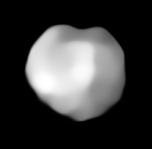(89) Julia
|
Asteroid (89) Julia |
|
|---|---|

|
|
| Image of (89) Julia - taken with the VLT- SPHERE telescope | |
| Properties of the orbit ( animation ) | |
| Orbit type | Main belt asteroid |
| Major semi-axis | 2.55 AU |
| eccentricity | 0.183 |
| Perihelion - aphelion | 2.083 AU - 3.017 AU |
| Inclination of the orbit plane | 16.1 ° |
| Length of the ascending node | 311.6 ° |
| Argument of the periapsis | 44.7 ° |
| Time of passage of the perihelion | August 9, 2009 |
| Sidereal period | 4 a 26 d |
| Mean orbital velocity | 18.5 km / s |
| Physical Properties | |
| Medium diameter | 145 km |
| Dimensions | (6.71 ± 1.82) 10 18 kg |
| Albedo | 0.19 |
| Medium density | 3.98 ± 1.27 g / cm³ |
| Rotation period | 11.4 h |
| Absolute brightness | 6.6 likes |
| Spectral class |
Tholen: S SMASSII: K |
| history | |
| Explorer | É. Stephan |
| Date of discovery | August 6, 1866 |
| Source: Unless otherwise stated, the data comes from JPL Small-Body Database Browser . The affiliation to an asteroid family is automatically determined from the AstDyS-2 database . Please also note the note on asteroid items. | |
(89) Julia is an asteroid of the main belt , which on August 6, 1866 by the French astronomer Édouard Stephan was discovered.
The asteroid was after the Holy Julia of Corsica , a martyr of the fifth century , named.
Julia family
(89) Julia is ancestral body of the Julia family of asteroids. This includes a good 30 objects.
Observations with the VLT-SPHERE telescope led to the discovery of about 70 km. large crater on the southern hemisphere of the asteroid. Its formation through the collision of the main body with an approximately 8 km large object is associated with the formation of the asteroid family. The crater is the only surface structure on the property to date to have been named after the Corsican community of Nonza .
Individual evidence
- ↑ a b Benoit Carry Density of Asteriods , Planetary & Space Science, 2012, Volume 73, Issue 1, pp. 98–118, doi: 10.1016 / j.pss.2012.03.009
- ^ Discovery Circumstances: Numbered Minor Planets. The international Astronomical Union - Minor Planet Center, accessed August 7, 2020 .
- ↑ D. Nesvorny, M. Broz, V. Carruba Identification and Dynamical Properties of Asteroid Families , 2014, arXiv: 1502.01628
- ↑ The impact crater at the origin of the Julia family detected with VLT / SPHERE? Astronomy & Astrophysics, accessed August 12, 2020 .
- ↑ ESO / VLT / SPHERE Survey of D> 100km Asteroids: First Results. USRA, accessed August 13, 2020 .